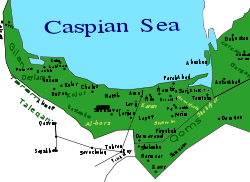Daylamites

The Daylamites or Dailamites were an Iranian people[1] inhabiting the mountainous regions of northern Iran on the southern shore of the Caspian Sea. They were employed as soldiers from the time of the Sasanian Empire, and long resisted the Arab conquest of Iran and subsequent Islamization. In the 930s, the Dailami Buyid dynasty emerged and managed to gain control over much of modern-day Iran, which it held until the coming of the Seljuk Turks in the mid-11th century.
History
The Dailamites lived in the highlands of Dailam, part of the Alborz mountain range, between Gilan and Tabaristan. However, the earliest Zoroastrian and Christian sources indicate that the Dailamites originally came from Anatolia near the Tigris River,[2] where Iranian ethnolinguistic groups including Dimli tribes live today.[3] They spoke the Deilami language, a northwestern Iranian dialect similar to that of the neighbouring Gilites.[4] Nestorian Christianity had spread among them due to the activities of John of Dailam, and bishoprics are reported in the remote area as late as the 790s, while it is possible that some remnants survived there until the 14th century.[4] During the Sasanian period, they were employed as high-quality infantry.[5] According to the Byzantine historians Procopius and Agathias, they were a warlike people and skilled in close combat, being armed each with a sword, a shield and spears or javelins. They supported the rebellion of Bahram Chobin against Khosrau II, but he later employed an elite detachment of 4,000 Dailamites as part of his guard.[4] The Sasanian general Wahriz, who was sent by Khosrau I in 570 to capture Yemen, was also probably of Dailamite descent, and his troops included Deilamites, who would later play a significant role in the conversion of Yemen to the nascent Islam.[4]
Some Muslim sources maintain that following the Persian defeat in the Battle of al-Qādisiyyah, the 4,000-strong Dailamite contingent of the Persian guard, along with other Persian units, defected to the Arab side, converting to Islam.[6] Nevertheless, the Dailamites managed to resist the Arab invasion of their own mountainous homeland for several centuries under their own local rulers.[4][7] Warfare in the region was endemic, with raids and counter-raids by both sides. Under the Arabs, the old Persian fortress-city of Qazvin continued in its Sasanian-era role as a bulwark against Dailamite raids. According to the historian al-Tabari, the Dailamites, along with the Turks, were considered the worst enemies of the Muslims.[4] The Abbasids penetrated the region and occupied parts of it, but their control was never very effective. During the reign of Harun al-Rashid, several Shia fled to the Dailamites, most of whom remained pagan, with a few Zoroastrians and Christians, to escape persecution. Among these refugees were the Alids, who began the gradual conversion of the Dailamites to Shia Islam.[4][8] Nevertheless, a strong Persian identity remained ingrained in the peoples of the region, along with an anti-Arab mentality. The local rulers, like the Ziyarid dynasty, made a point of celebrating old Iranian and Zoroastrian festivals.[7]
A modern offshoot of the Dailamites are known under the name of Delaim or Dulaim tribe in Iraq.
References
- ^ Michael Fishbein, "e History of Al-Tabari: The Victory of the Marwanids A.D. 685-693/A.H.", SUNY Press, 1990. Page 90 excerpt: "Note 336: The Daylamites were an Iranian People living in the highlands of Gilan in northern Iran. They had served the Sassanians as mercenaries and stubbornly maintained their independence despite many Muslim expeditions against them.
- ^ Dadagi, Farnbagh. Bahar, Mehrdad. "Bundahishn." Tus, 1991
- ^ Duus (EDT) Extra, D. (Durk) Gorter, Guus Extra, The Other Languages of Europe: Demographic, Sociolinguistic and Educational Perspectives, Multilingual Matters (2001). ISBN 1-85359-509-8
- ^ a b c d e f g Encyclopedia Iranica
- ^ Frrokh (2007), pp. 201, 224, 231
- ^ Farrokh (2007), p. 269
- ^ a b Price (2005), p. 42
- ^ Farrokh (2007), pp. 274-275
Sources
- Felix, Wolfgang; Madelung, Wilfert. "Deylamites". Encyclopedia Iranica. Retrieved 1 August 2012.
- Farrokh, Kaveh (2007). Shadows in the Desert: Ancient Persia at War. Osprey Publishing. ISBN 1-84603-108-7.
- Price, Massoume (2005). Iran's diverse peoples. ABC-CLIO. ISBN 978-1-57607-993-5.
- Fisher, William B.; Frye, Richard Nelson, eds. (1975). The Cambridge History of Iran: The period from the Arab invasion to the Saljuqs. Cambridge University Press. ISBN 978-0-521-20093-6.
